Introduction
Welcome to Forum 43. This issue contains important information on events in the SUES summer programme, so please make sure the dates are in your diary. We also include some thought-provoking articles from Mary Ormsby and Roger Mitchell.
To coincide with the Coronation earlier this month, Mary has been looking into how the four coronations of the 20th century were celebrated in the village of Scarisbrick. She notes the absence of any such events in the village this time round, and considers the likely reasons.
Roger has been thinking about one of the questions in Mary’s history quiz in Forum 42, about Britain’s position at the time of the American Civil War. He comes to the conclusion that nothing is simple!
Alan Potter’s course on Uncovering the Mystery of Chemistry started on 8th May. Sadly, I missed the first two lectures due to illness, but Siobhan tells me that it’s excellent (of course), and she has made very comprehensive notes, enabling me to tackle the ‘homework’. I’m really looking forward to attending the rest of the course in person.
Finally, I am sure that many of you have knowledge and expertise on a wide range of subjects that would be of interest to your fellow SUES members, and which could form the basis of an article for Forum. If you would like to contribute something, please let me know – my contact details are on page 6.
Chris Nelson
SUES Programme May – August 2023
Our busy programme continues into the summer months. Alan Potter’s fascinating course on ‘The Mystery of Chemistry’ finishes in early June and we then have two meetings at All Saints and an excursion before the end of August. Our special anniversary programme begins in September, and information on this will be included in the June issue of Forum.
Friday 23rd June at 2.30pm
‘Victorian Visitors to Southport’. Michelle Caldwell
Michelle Caldwell’s lecture is based on research that she is undertaking at Edge Hill University. She organised an exhibition with this title at the Atkinson in 2022 and will introduce us to many of the great and the good (and the not so good) of Victorian England.
Wednesday 12th July at 2.30pm
AGM, followed by:
‘The University Extension Movement in Southport 1874 – 2024’. Peter Firth
Peter Firth introduces us to the research that he is doing on the history of SUES and its links to the wider history of the University Extension movement.
Refreshments will be served at both these meetings.
Thursday 31st August at 2.30pm.
Visit to Meols Hall
Following on from last year’s highly successful visit to Scarisbrick Hall, we will be visiting another local country house. This time the house will be Meols Hall, Churchtown. Much of the house was rebuilt in the 1960s, although it is hardly typical of that decade. Roger Hesketh used material from 18th century houses that had been demolished in the 1950s. The result has been described as ‘one of the most successful country houses created in England since the Second World War’. The house also has an excellent picture collection. For the full ‘country house experience’, we hope to arrange for afternoon tea in Churchtown afterwards. Further details and a booking form will be in the June edition of Forum.
Roger Mitchell
Past Coronation Celebrations in Scarisbrick
In the days before the Coronation of King Charles III, I decided to see how earlier Royal Coronations had been celebrated in Scarisbrick. The earliest record I found for such a celebration was that for the coronation of Edward VII in 1902, but looking at records of other Royal celebrations it became clear that the plan for the day was based on the celebration held to commemorate the Diamond Jubilee of Queen Victoria in Scarisbrick Park on Wednesday 21st July 1897. This is recorded in detail in a booklet produced to commemorate the occasion.
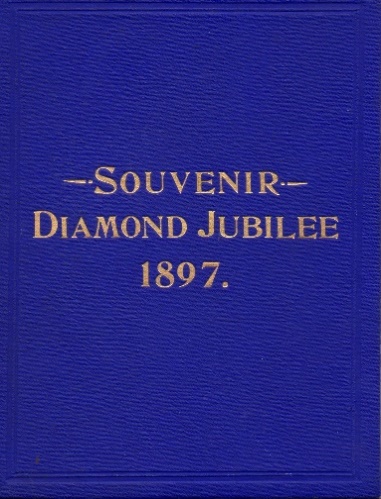
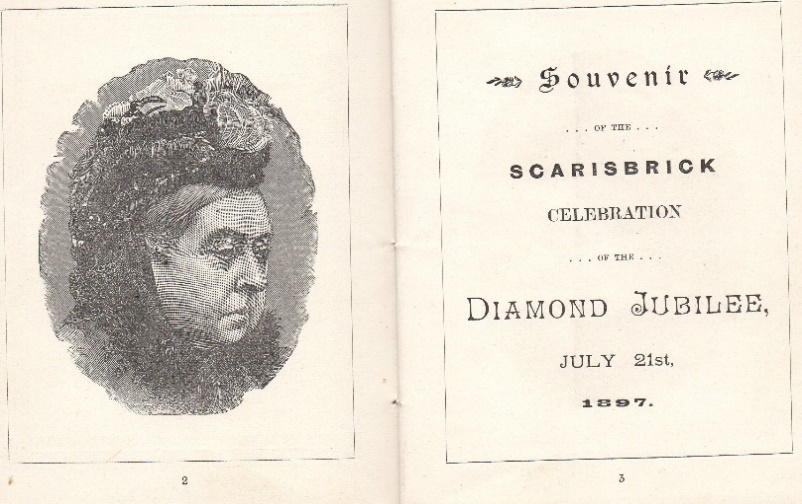
All of the celebrations (1902, 1911, 1937 & 1953) have followed a similar format. A committee was formed to plan the event with representatives of all the religious denominations in the village and members of the Parish Council. Until the celebration of 1953, the day’s event was under the patronage of the owner of the Hall, the Marquises de Castéja in 1902 and 1911 and Sir Everard Scarisbrick in 1937. Scarisbrick Hall parklands was the location for these celebrations, but in 1953, when the Hall was a Teacher Training College, the celebration was held on the land of Mr Thomas Ackers in Bescar.
All the days’ programme was “devoted chiefly to the enjoyment of the children of the tenantry”. According to the Ormskirk Advertiser the events were “Red letter days” for the village with “pretty invitations” sent out for the event to a large number of people, not only from Scarisbrick but from Southport and Ormskirk too.
The plan for the days was always the same. The celebration started by the children assembling in their schools at midday, often receiving commemorative medals, and then coming together at St Mary’s Bescar to form a joint procession to the Hall which set out at 1 pm. The procession was led by stewards followed by carriages carrying the village clergy and local dignitaries. A brass band then led the school children, dressed in their best clothes carrying flags and banners. The youngest children were transported in decorated vehicles, initially horse drawn, but by 1953 these were motor wagons. The procession was sometimes joined by members of the local Odd Fellows lodge and in 1902 several cyclists in fancy dress brought up the rear.
Once in the Park, the children were presented with celebration cups and given a free afternoon tea, sometimes in a marquee. Teas were also given free to ex-servicemen and those over 65 years of age. Other adults could purchase refreshments at a reasonable cost.
There was the usual singing of the National Anthem and toasts to both the King/Queen and those who had made the event possible. On at least two occasions trees were planted to mark the event, and there was always an extensive programme of sports for both adults and children with many prizes donated by local businesses in both Ormskirk and Southport.
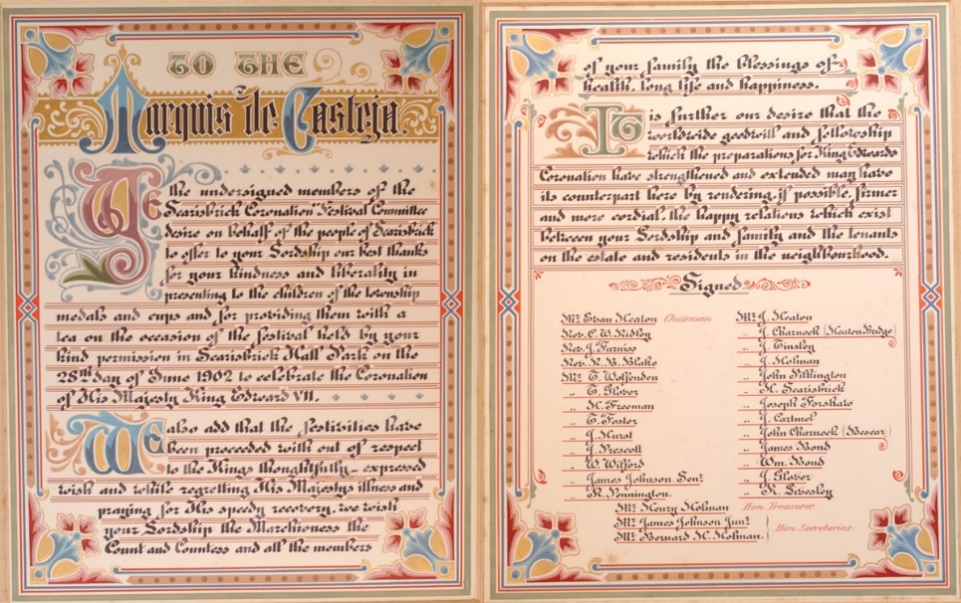
Entertainment in the form of a Punch & Judy show was provided in the courtyard and at some celebrations there were stalls. In 1937 the proceeds of the ‘Bring & Buy Stall’ were donated to the Ormskirk & District Cancer Appeal of which Lady Scarisbrick was the patron. When the events were held at the Hall the day usually ended with dancing in the courtyard and a firework display over the lake.
The cost of the event was covered in different ways. When the event was held in the Park, either the Marquis or Sir Everard made a substantial contribution, the remainder being made up by funds from the Parish Council, who raised it via a levy on the rates, and ‘personal subscriptions. If any money was left over after the event, it was usually given to the ‘widows of the parish’.
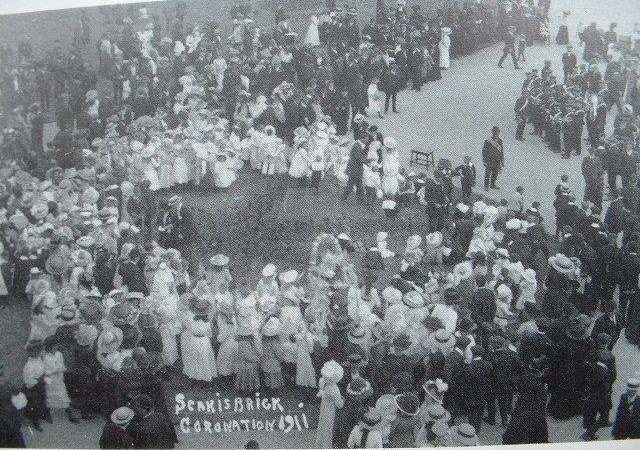
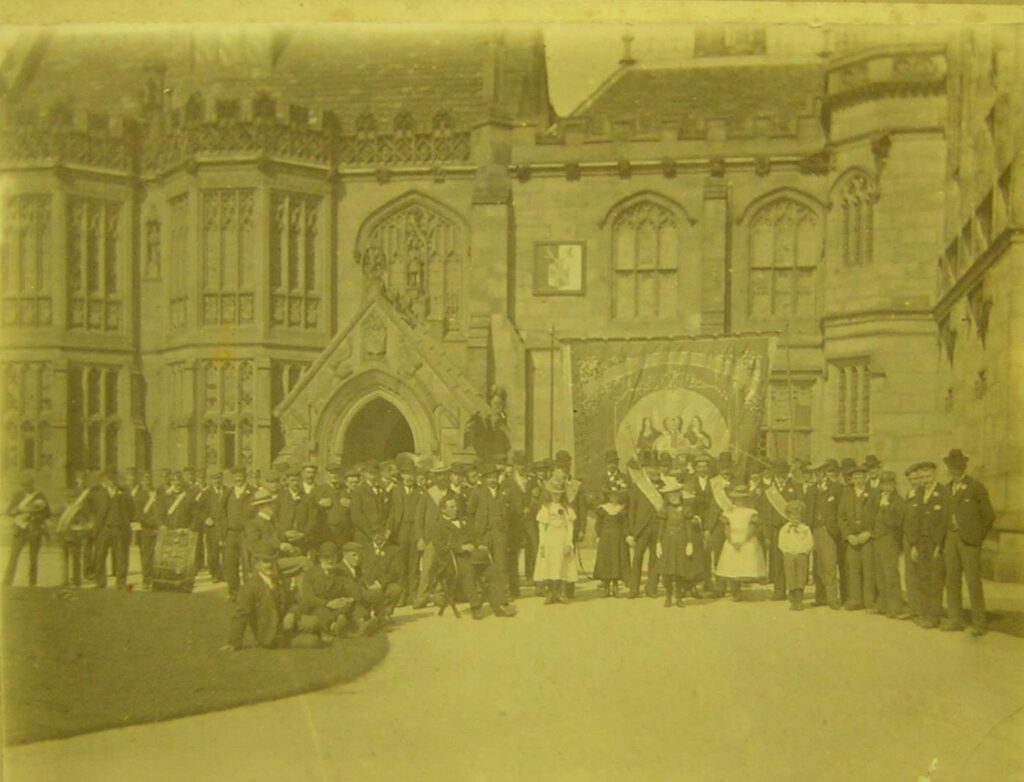
(Note the Hatchment with the Castéja Coat of Arms. Marie Emmanuel died in February that year)
In 2023 no village celebration of the Coronation was organized. It is a reflection on the changed nature of Scarisbrick from a mainly agricultural village to a dormitory village today. The statistics show the change. There are now less than 200 children across the three village primary schools, compared to almost 800 in 1902, and many of these travel to school from outside the village. The nature of the workplace has changed too. In 1891 the census shows over 59.5% of the population in Scarisbrick were farmers or agricultural labourers (the total would be higher if farm related occupations such as blacksmiths were included); this compares with 4.3% in the latest census of 2021, which also shows 24.7% of people travel more than 10km (so that is outside of the village) to work.
In an interesting coincidence on May 6th, the day King Charles III was crowned, the second son of the current Marquis de Castéja was married in the South of France. We can only imagine what a celebration the village might have had if the family had not sold the Hall and Estate in 1923, or would they?
Mary Ormsby
The Trouble With History
Simple Questions and Complex Answers
Although I say it myself, I was doing rather well with the History Quiz in Forum 42. I had no problems with Domesday Book or Francis Drake, Bosworth Field or the Luddites but having got as far as question 18, I suddenly encountered difficulties. I wasn’t expecting a problem, because only four answers are possible to the question ‘Which side did Britain support in the US Civil War?’ It could be the Union (the North), the Confederacy (the South), it could be neither or it could be both. In the end I went for ‘all of the above’ but that was not the published answer. Reading the question more carefully, I should have realised that there would inevitably be problems. Two of the ten words in the question are less than straightforward. ‘Britain’ could mean the British people or the British government and, as football fans know, ‘support’ can range from a cursory glance at the sports pages of a Monday newspaper to a 320-mile return trip to Grimsby on a wet Wednesday in November. So how would different sorts of quizzers respond? Bear in mind that the question setter decided upon the Confederacy as the ‘correct’ answer.
Lawyers would probably go for ‘neither’ because Britain remained neutral throughout the war. It did recognise ‘the belligerent status’ of the Confederate States but did not make any treaty or indeed exchange ambassadors.
Populists might claim ‘both’ because around 50,000 British citizens took part in the conflict with roughly equal numbers supporting either side. Many more citizens had absolutely no intention of leaving home to fight but nevertheless took sides, wrote letters and signed petitions. Lancashire was probably the most deeply divided of all English counties. There was much support for the Confederacy in Liverpool whereas Manchester and the cotton towns tended to support the Union, even though its navy was preventing the export of cotton and therefore causing the widespread distress of the cotton famine. A famous letter from President Lincoln acknowledged Lancashire’s contribution to the ending of slavery.
Romantics would probably choose the Confederacy, because rather like the verdict of ‘Ten Sixty Six and All That’ on the two sides in the English Civil War, the South could be described as ‘Wrong but Romantic’ while the North was rather unfairly judged as ‘Right but Repulsive’. The South was the underdog, but showed great courage and considerable bravura. Had it not been for slavery, many of the English landed gentry, including some MPs, would have given strong support to their American counterparts in the Southern states and their desire for independence. It is worth remembering that the final confederate surrender took place not at Appomattox Courthouse in April 1865, when Robert E Lee surrendered to Ulysses S Grant, but in November 1865 at the Pierhead in Liverpool when the captain of the confederate commerce raider, Shenandoah, surrendered to the British navy.
Pragmatists would argue that Britain provided just as much support as the North needed or wanted. The North preferred British neutrality to British intervention. As long as Britain and France kept out and as long as the North held its nerve and maintained its morale, a Union victory was almost inevitable and the Reunited States could then determine their future without European influence. It was the Confederacy who needed British support and they never got it, even though crises over two ships, the Trent and the Alabama, raised Confederate hopes.
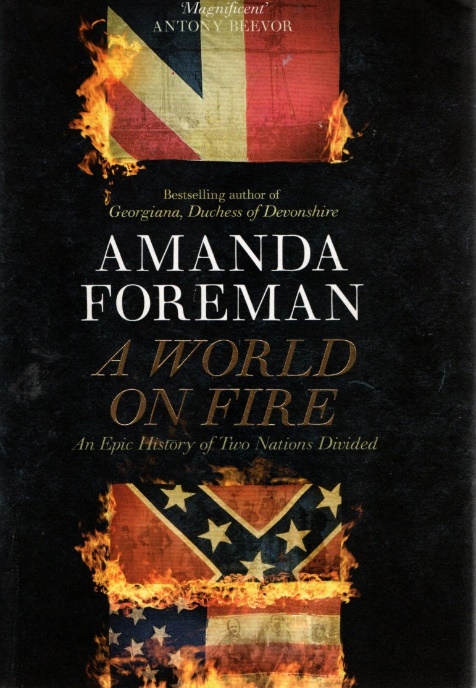
My rejected answer has stimulated my curiosity to discover more and I have turned to a book that has for a number of years languished unread on my book shelves. It is Amanda Foreman’s ‘A World on Fire – an epic history of two nations divided’. It was published in 2010, eleven years after her previous best seller ‘Georgiana, Duchess of Devonshire’. It weighs in at well over 4lbs and has just over 1,000 pages. She explains that it took so long because it is such a complex story, but I note that it is dedicated to ‘the children’ and there turn out to be five of them, all born within that first decade of the 21st century. My reading of it should have fewer interruptions but her writing will need to sustain my interest. If it does, watch out for a Forum Review. If it doesn’t, perhaps I will try to refrain from the Forum Quiz in future.
Roger Mitchell
Contacts
Chair: Alan Potter
alanspotter@hotmail.com
07713 428670
Secretary: Roger Mitchell
rg.mitchell@btinternet.com
01695 423594 (Texts preferred to calls)
Membership Secretary: Rob Firth
suesmembers74@gmail.com
01704 535914
Forum Editor: Chris Nelson
chris@niddart.co.uk
07960 117719
Facebook: facebook.com/groups/southportues
See our archive for previous editions of the SUES Forum!